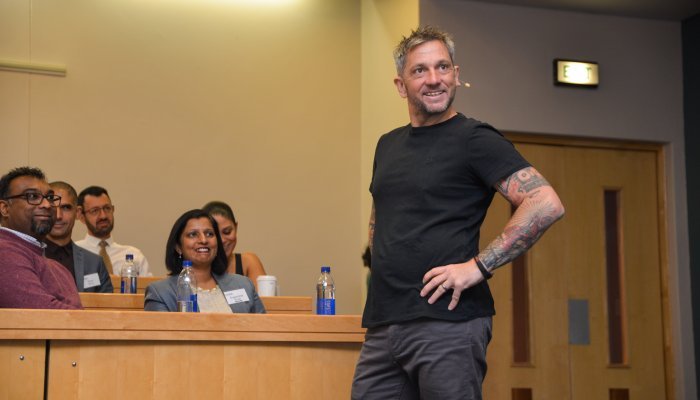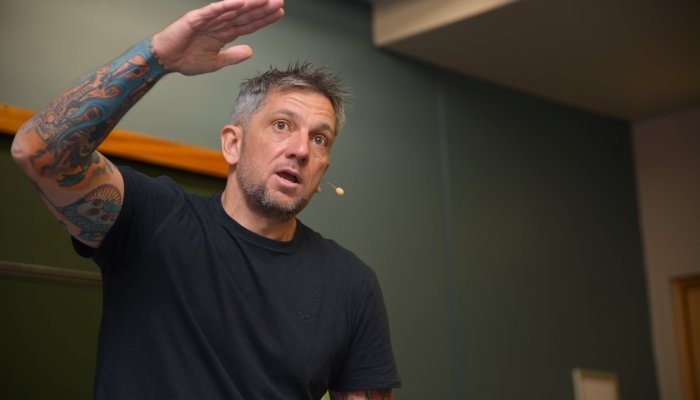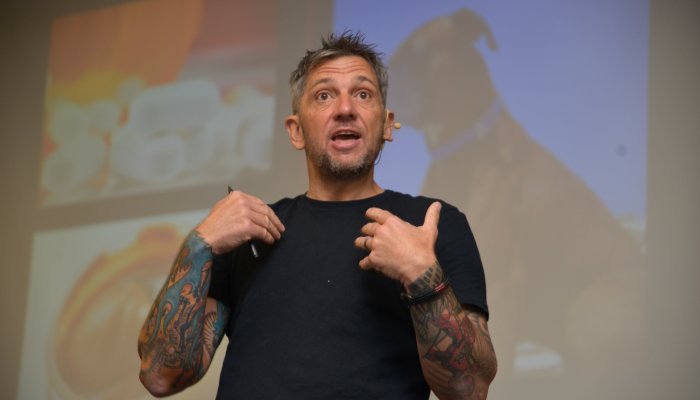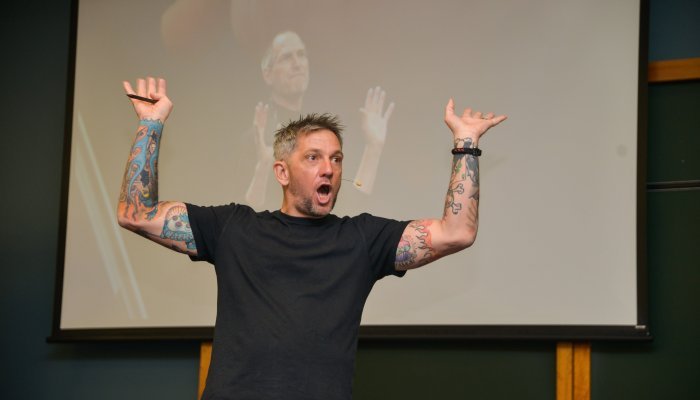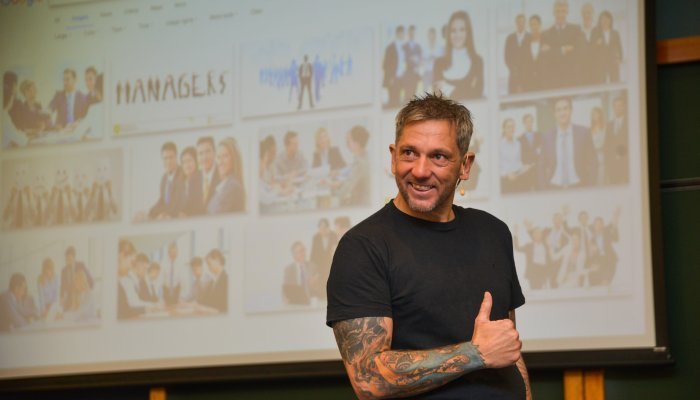Richard Mulholland, co-founder of global presentation businesses Missing Link and TalkDrawer, recently hosted a 90-minute How to Present Like a Pro Masterclass at GIBS aimed at taking some of the terror out of speaking in public.
Uniquely qualified to give advice in this area, Mulholland is a South African-born public speaker who has shared his insights in more than 30 countries on six continents. His work has included addressing global CEOs and sharing his ideas on the global TED Talks platform. He is also the author of two acclaimed books.
Mulholland believes that the ability to communicate ideas clearly and succinctly is an essential tool in every executive’s skills set. And yet, when it comes to public speaking, Mulholland believes most leaders “do not listen their way to leadership. You need to listen, process, and then stand and deliver. Drive your people forward.”
The Masterclass offered a taste of what to expect from Mulholland’s book on the subject, Boredom Slayer: A Speaker’s Guide to Presenting Like a Pro.
BOX 1
Presentation myths and other no-nos
Death by PowerPoint
“Leave PowerPoint alone!” Mulholland said, opening his PowerPoint presentation. He then shared a thought: “PowerPoint is not sh*t; you are sh*t!”
Mulholland stressed that PowerPoint is a valuable tool and blaming a bad presentation on PowerPoint is like blaming a pan for serving up a bad meal. “Good visuals can help you make your point,” he said. Mulholland’s PowerPoint presentation did not contain reams of words and bullet points. In fact, very little of what Mulholland had on his PowerPoint presentation repeated anything he said. Rather, it popped with strong images, quotes and bright colours.
For example, during Mulholland’s presentation, a large picture of a boxer dog appeared. It had very little to do with his presentation and yet it captured people’s interest – only then did Mulholland relate a story about feeding his dog pills using peanut butter (see next point).
Tell a story
“Nobody cares about your story. They want your lessons to help them write a better version of their story.”
Back to the dog. Mulholland explained that lessons are often bitter pills, and bitter pills are easier to swallow with peanut butter. So, the information can be hard-hitting, and numbers can tell a less-than-happy story, but if you serve it up in an entertaining and engaging way, your audience will be happy to hear what you have to say. As Mulholland said: “Wrap your presentation well. We need both bitter and sweet.” Interestingly, Mulholland reassured the audience that the wrapping does not have to be funny. If humour is not your thing, don’t use it. Which brings us to the next point.
Know your audience
“You cannot possibly know your audience, but remember they do have an authenticity detector,” said Mulholland. He stressed that being true to yourself is key to a good presentation: “Be the best version of yourself. People will take anything as long as it is authentic.”
Mulholland is loud, outgoing and funny with a tendency to use colourful language. But he is unapologetically authentic. He is a man covered in tattoos, wears black jeans and a t-shirt, and has leather bands on his wrists. This is his style. He does not present to CEOs wearing a suit. That would be inauthentic.
His message was clear – use what you have in your arsenal, but never try to copy someone else. If you are quiet and unassuming, use that to your advantage. If you are loud, be loud. Acerbic? Let the sarcasm rip. The content of your presentation is what will engage people, not how much of a showman you are. Which is our segue to the next point.
You have to be a great writer
Mulholland believes that being a great speaker is about knowing how to write a great talk. The foundations to nailing a great presentation are laid long before you stand up and deliver. If your structure is bad, your talk will be bad. “You write a good talk long before you deliver one,” he explained, stressing that flow is critical.
The structure of an outstanding talk
Give them a reason to care
Why are people listening to you? Why should they care enough to sit through your presentation? This part of your presentation must show the audience how they are going to benefit.
For example, Mulholland began by outlining the myths of presentations. The audience was hooked with a subject that was important to them. “Buy their attention before you sell them anything. At this stage they have an empty sh*t tank that you need to fill up,” he explained.
Give them a reason to believe
This where you explain why you have the right to share this information. Share your experience and qualifications and what you bring to the table.
Mulholland, for example, gave a quick overview of his biography, his experience and the countries in which he has delivered addresses. He dropped a few names and shared stories around giving TED Talks. However, this was not simply a rundown of his CV, but rather, he cleverly let stories and anecdotes do the talking.
Tell them what they need to know
“This is the payload of your presentation,” stressed Mulholland. This is where you talk about your Unique Selling Point (USP). What is your value proposition? What is the thing you are uniquely qualified to solve? Where does your expertise lie?
This section requires something special. By doing it the right way, you can get a good proportion of people onboard with your ideas. So, make sure you explain what you can do for them in the most creative way. Make sure that your audience believes that your USP is important and impressive.
For example, this is where Mulholland not only shared is insights around enhancing presentation skills, but also displayed what it means to give an outstanding talk. As an experienced public speaker, Mulholland showed how he uses PowerPoint to give maximum impact to his presentation. He showed what it means to be authentic. He proved that he uses his own tips when designing a presentation. Ultimately, this is where Mulholland delivered on his promise to share his knowledge and give the audience the lessons they wanted to become better versions of themselves.
Tell them what they need to do
“Tell your audience what to do, otherwise they will do nothing.” Quoting an anonymous quote, Mulholland added: “If action followed knowledge, we’d all have six-packs.”
People can read and hear as much as they like, but it has no use if they don’t put it into action. You have to outline the action steps your audience needs to take, otherwise you won’t be “burning your knowledge calories”, just “gaining knowledge weight”.
In Mulholland’s presentation, for example, he suggested that audience members go out and sign up for a course like Toastmasters to improve their speaking. They could also investigate his TalkDrawer offering, which gives users ready-to-use 10-minute presentations. Above all, he urged the audience to get out there and start practicing by giving presentations.
Masterclass Q&A
Mulholland was inundated with questions during the session…
How do you develop energy if you are just an average person, more restrained or more corporate?
You need to be compelling and interesting. Write the right story. Don’t emulate anybody, rather do you well. Focus on your message and do it well.
How do you stick to your authentic self when you are under pressure?
Most people believe they have to behave a certain way. If you are in the market for ‘boring’, you’re spoilt for choice. You were employed because you were different. Look like yourself, act like yourself, speak like yourself – not like everyone else.
What if I’m authentically incredibly nervous? How do you get over that?
This is a narrative we feed ourselves. Stop believing public speaking is scary. Speaking is such fun; people laugh at your jokes! We have to be careful of not becoming victims; speaking is the most empowering thing you can do. My tip: Develop a ritual to psych yourself up before speaking.
How can you go from bad to good when using PowerPoint?
I try not to make it obvious that I am looking at my slides. I recommend that you don’t use bullet points, don’t give away your joke too early, and pictures should not make sense immediately. Start with a picture and then tell the story, that way you build curiosity. Audiences like to try and figure things out. Let them figure out the joke before you deliver the punchline.
How can you get sustained change? I took the first step but had no follow-through?
Practice. Use our TalkDrawer presentations and practice in public. Practice makes perfect. Then when you have to present for real, you will be great.
How do you deal with different cultures?
Always be authentic. Invite them into your world, where you are comfortable, then they will love it and they will love you.
Should you memorise your presentation or notes?
Use notes if you want to. Say: “I am very nervous; do you mind if I use my notes?” Do be careful, however, that you don’t become addicted to using notes. That is why I prefer slides. Memorising each word will make you panic; rather use your slides as a guide.
How do you wing it when there is a power outage?
Always work under the assumption that technology will fail you. I know my presentations well enough to talk without the use of slides. Audiences are very sympathetic in these instances.
What can you say about voice projection?
To make an impact you must be able to modulate your voice, take your audience up and then let them down. One pitch is boring. Also, never yell at your audience as it will sound like an attack.
Can you reset if people do not like you?
The more comfortable you are with speaking, the more able you will be to self-correct. Also, never attack your audience, their industry or their values. Rather give them the ‘bitter pill’ through the use of metaphors.


